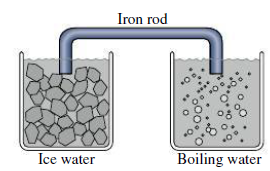
ESSENTIAL UNIV.PHYS.-MOD.MASTERING(18W)
4th Edition
ISBN: 9780136780984
Author: Wolfson
Publisher: PEARSON
expand_more
expand_more
format_list_bulleted
Concept explainers
Textbook Question
Chapter 16, Problem 62P
One end of an iron rod 40 cm long and 3.0 cm in diameter is in ice water, the other in boiling water (Fig. 16.15). The rod is well insulated so no heat is lost out the sides. Find the heat-flow rate along the rod.

FIGURE 16.15 Problem 60
Expert Solution & Answer
Want to see the full answer?
Check out a sample textbook solution
Students have asked these similar questions
Please solve and answer the question correctly please. Thank you!!
Please solve and answer the question correctly please. Thank you!!
Please view both photos, and answer the question correctly please. Thank you!!
Chapter 16 Solutions
ESSENTIAL UNIV.PHYS.-MOD.MASTERING(18W)
Ch. 16.1 - Is there (a) no temperature, (b) one temperature,...Ch. 16.2 - A hot rock with mass 250 g is dropped into an...Ch. 16.3 - The figure shows three slabs with the same...Ch. 16.3 - Prob. 16.4GICh. 16.4 - A houses thermostat fails, leaving the furnace...Ch. 16 - Does a thermometer measure its own temperature or...Ch. 16 - Compare the relative sizes of the kelvin, the...Ch. 16 - If you put a thermometer in direct sunlight, what...Ch. 16 - Why does the temperature in a stone building...Ch. 16 - Why do large bodies of water exert a...
Ch. 16 - Stainless-steel cookware often has a layer of...Ch. 16 - Prob. 7FTDCh. 16 - Glass and fiberglass are made from the same...Ch. 16 - To keep your hands warm while skiing, you should...Ch. 16 - Global warming at Earths surface is generally...Ch. 16 - Prob. 11ECh. 16 - A Canadian meteorologist predicts an overnight low...Ch. 16 - Normal room temperature is 68F. Whats this in...Ch. 16 - Prob. 14ECh. 16 - At what temperature do the Fahrenheit and Celsius...Ch. 16 - The normal boiling point of nitrogen is 77.3 K....Ch. 16 - Prob. 17ECh. 16 - Prob. 18ECh. 16 - Prob. 19ECh. 16 - Whats the specific heat of a material if it takes...Ch. 16 - The average human diet contains about 2000 kcal...Ch. 16 - Prob. 22ECh. 16 - Prob. 23ECh. 16 - Building heat loss in the United States is usually...Ch. 16 - Find the heat-loss rate through a slab of (a) wood...Ch. 16 - Youre a builder whos advising a homeowner to have...Ch. 16 - An 8.0 m by 12 m house is built on a concrete slab...Ch. 16 - Find the -factor for a wall that loses 0.040 Btu...Ch. 16 - Compute the -factors for 1-inch thicknesses of...Ch. 16 - A horseshoe has surface area 50 cm2, and a...Ch. 16 - An oven loses energy at the rate of 14 W per C...Ch. 16 - Youre having your homes heating system replaced,...Ch. 16 - The filament of a 100-W lightbulb is at 3.0 kK....Ch. 16 - A typical human body has surface area 1.4 nr and...Ch. 16 - Example 16.2: An iron frying pan of mass 2.65 kg...Ch. 16 - Prob. 36ECh. 16 - Example 16.2: During the refueling of a nuclear...Ch. 16 - Prob. 38ECh. 16 - Example 16.7: A solar greenhouse has 435 ft2 of...Ch. 16 - Prob. 40ECh. 16 - Example 16.7: An asteroid in the belt between Mars...Ch. 16 - A constant-volume gas thermometer is filled with...Ch. 16 - A constant-volume gas thermometer is at 55-kPa...Ch. 16 - In Fig. 16.2s gas thermometer, the height h is...Ch. 16 - Prob. 46PCh. 16 - Typical fats contain about 9 kcal per gram. If the...Ch. 16 - A circular lake 1.0 km in diameter is 10 m deep...Ch. 16 - How much heat is required to raise an 800-g copper...Ch. 16 - Initially, 100 g of water and 100 g of another...Ch. 16 - Prob. 51PCh. 16 - Two neighbors return from Florida to find their...Ch. 16 - Prob. 53PCh. 16 - In the 2011 nuclear accident at Fukushima, Japan,...Ch. 16 - Prob. 55PCh. 16 - The temperature of the eardrum provides a reliable...Ch. 16 - Prob. 57PCh. 16 - Prob. 58PCh. 16 - A piece of copper at 300C is dropped into 1.0 kg...Ch. 16 - While camping, you boil water to make spaghetti....Ch. 16 - A biology labs walk-in cooler measures 3.0 m by...Ch. 16 - One end of an iron rod 40 cm long and 3.0 cm in...Ch. 16 - Prob. 63PCh. 16 - An electric stove burner has surface area 325 cm2...Ch. 16 - Youre considering purchasing a new sleeping bag...Ch. 16 - A blacksmith heats a 1.1-kg iron horseshoe to...Ch. 16 - Whats the power output of a microwave oven that...Ch. 16 - A cylindrical log 15 cm in diameter and 65 cm long...Ch. 16 - A blue giant star whose surface temperature is 23...Ch. 16 - Prob. 71PCh. 16 - Prob. 72PCh. 16 - Estimate the average temperature on Pluto,...Ch. 16 - Prob. 74PCh. 16 - Prob. 75PCh. 16 - Prob. 76PCh. 16 - Prob. 77PCh. 16 - In a cylindrical pipe where area isnt constant....Ch. 16 - Prob. 79PCh. 16 - Prob. 80PCh. 16 - A passive solar house has south-facing windows...Ch. 16 - A more realistic approach to the solar greenhouse...Ch. 16 - Fiberglass is a popular, economical, and fairly...Ch. 16 - Fiberglass is a popular, economical, and fairly...Ch. 16 - Fiberglass is a popular, economical, and fairly...Ch. 16 - Fiberglass is a popular, economical, and fairly...
Additional Science Textbook Solutions
Find more solutions based on key concepts
QIdentify (stepwise) the process of purifying drinking water. What important contaminants are targeted by each ...
Brock Biology of Microorganisms (15th Edition)
With what geologic feature are the earthquakes in the mid-Atlantic associated?
Applications and Investigations in Earth Science (9th Edition)
Use the key to classify each of the following described tissue types into one of the four major tissue categori...
Anatomy & Physiology (6th Edition)
APPLY 1.2 Express the following quantities in scientific notation
using fundamental SI units of mass and lengt...
Chemistry (7th Edition)
All of the following terms can appropriately describe humans except: a. primary consumer b. autotroph c. hetero...
Human Biology: Concepts and Current Issues (8th Edition)
1. Which parts of the skeleton belong to the appendicular skeleton? Which belong to the axial skeleton?
Human Anatomy & Physiology (2nd Edition)
Knowledge Booster
Learn more about
Need a deep-dive on the concept behind this application? Look no further. Learn more about this topic, physics and related others by exploring similar questions and additional content below.Similar questions
- A thrown brick hits a window, but doesn't break it. Instead it reverses direction and ends down on the ground below the window. Since the brick didn't break the glass, we know: О The force of the brick on the glass > the force of the glass on the brick. О The force of the brick on the glass the force of the glass on the brick. = О The force of the brick on the glass < the force of the glass on the brick. О The brick didn't slow down as it broke the glass.arrow_forwardAlexandra (wearing rubber boots for traction) is attempting to drag her 32.6-kg Golden Retriever across the smooth ice by applying a horizontal force. What force must she apply to move the dog with a constant speed of 0.950 m/s? ☐ 31.0 lb. ☐ 319 kg. ○ Zero. 32.6 kg.arrow_forwardThe figure shows a graph of the acceleration of an object as a function of the net force acting on it. The mass of this object, in grams, is closest to 11 a(m/s²) 8.0+ 6.0- 4.0- 2.0- 0+ F(N) 0.00 0.50 1.00 ☐ 130 ○ 8000 ☐ 89arrow_forward
- Values that are within standard deviations represent measurements that are considered to be near the true value. Review the data from the lab and determine whether your data is within standard deviations. Report, using numerical values, whether your data for each angle is within standard deviations. An acceptable margin of error typically falls between 4% and 8% at the 95% confidence level. Review your data for each angle to determine whether the margin of error is within an acceptable range. Report with numerical values, whether your data for each angle is within an acceptable margin of error. Can you help explain what my data means in terms of the standard deviation and the ME? Thanks!arrow_forwardA sinusoidal wave is propagating along a stretched string that lies along the x-axis. The displacement of the string as a function of time is graphed in (Figure 1) for particles at x = 0 and at x = 0.0900 m. You are told that the two points x = 0 and x = 0.0900 m are within one wavelength of each other. If the wave is moving in the +x-direction, determine the wavelength. If instead the wave is moving in the -x-direction, determine the wavelength. Please show all stepsarrow_forwardYou are designing a two-string instrument with metal strings 35.0 cm long, as shown in (Figure 1). Both strings are under the same tension. String S1 has a mass of 8.30 g and produces the note middle C (frequency 262 Hz ) in its fundamental mode. What should be the tension in the string? What should be the mass of string S2 so that it will produce A-sharp (frequency 466 Hz ) as its fundamental? To extend the range of your instrument, you include a fret located just under the strings but not normally touching them. How far from the upper end should you put this fret so that when you press S1 tightly against it, this string will produce C-sharp (frequency 277 Hz ) in its fundamental? That is, what is x in the figure? If you press S2 against the fret, what frequency of sound will it produce in its fundamental?arrow_forward
- Please solve and answer the problem correctly please. Thank you!!arrow_forwardPlease help explain this. The experiment without the sandpaper had a 5% experimental error, with sandpaper it is 9.4%. Would the explaination be similar to the experiment without sandpaper? Thanks!arrow_forwardA sinusoidal wave with wavelength 0.400 m travels along a string. The maximum transverse speed of a point on the string is 3.00 m/s and the maximum transverse acceleration is 8.10×104m/s2. What is the propagation speed v of the wave? What is the amplitude A of the wave?arrow_forward
arrow_back_ios
SEE MORE QUESTIONS
arrow_forward_ios
Recommended textbooks for you
 Principles of Physics: A Calculus-Based TextPhysicsISBN:9781133104261Author:Raymond A. Serway, John W. JewettPublisher:Cengage Learning
Principles of Physics: A Calculus-Based TextPhysicsISBN:9781133104261Author:Raymond A. Serway, John W. JewettPublisher:Cengage Learning Physics for Scientists and Engineers: Foundations...PhysicsISBN:9781133939146Author:Katz, Debora M.Publisher:Cengage Learning
Physics for Scientists and Engineers: Foundations...PhysicsISBN:9781133939146Author:Katz, Debora M.Publisher:Cengage Learning College PhysicsPhysicsISBN:9781305952300Author:Raymond A. Serway, Chris VuillePublisher:Cengage Learning
College PhysicsPhysicsISBN:9781305952300Author:Raymond A. Serway, Chris VuillePublisher:Cengage Learning College PhysicsPhysicsISBN:9781285737027Author:Raymond A. Serway, Chris VuillePublisher:Cengage Learning
College PhysicsPhysicsISBN:9781285737027Author:Raymond A. Serway, Chris VuillePublisher:Cengage Learning
 College PhysicsPhysicsISBN:9781938168000Author:Paul Peter Urone, Roger HinrichsPublisher:OpenStax College
College PhysicsPhysicsISBN:9781938168000Author:Paul Peter Urone, Roger HinrichsPublisher:OpenStax College

Principles of Physics: A Calculus-Based Text
Physics
ISBN:9781133104261
Author:Raymond A. Serway, John W. Jewett
Publisher:Cengage Learning

Physics for Scientists and Engineers: Foundations...
Physics
ISBN:9781133939146
Author:Katz, Debora M.
Publisher:Cengage Learning

College Physics
Physics
ISBN:9781305952300
Author:Raymond A. Serway, Chris Vuille
Publisher:Cengage Learning

College Physics
Physics
ISBN:9781285737027
Author:Raymond A. Serway, Chris Vuille
Publisher:Cengage Learning


College Physics
Physics
ISBN:9781938168000
Author:Paul Peter Urone, Roger Hinrichs
Publisher:OpenStax College
Heat Transfer: Crash Course Engineering #14; Author: CrashCourse;https://www.youtube.com/watch?v=YK7G6l_K6sA;License: Standard YouTube License, CC-BY